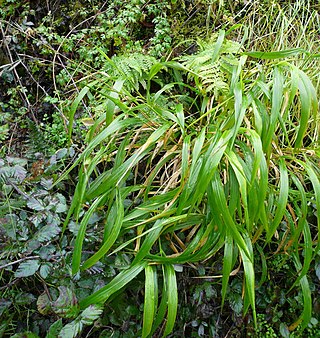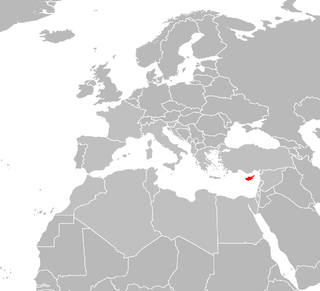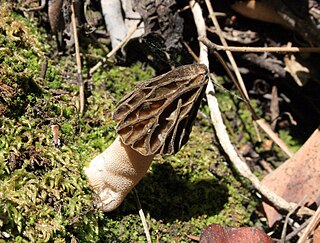
Northern Cyprus, officially the Turkish Republic of Northern Cyprus (TRNC), is a de facto state that comprises the northeastern portion of the island of Cyprus. It is recognised only by Turkey, and its territory is considered by all other states to be part of the Republic of Cyprus.

Aetokremnos is a rock shelter near Limassol on the southern coast of Cyprus. It is widely considered to host the oldest evidence of human habitation of Cyprus, dating to around 12,000 years ago. It is situated on a steep cliff site c. 40 m (131.23 ft) above the Mediterranean sea. The name means "Cliff of the eagles" in Greek. Around 40 m2 (430.56 sq ft) have been excavated and out of the four layers documented, the third is sterile.

Brachypodium sylvaticum, commonly known as false-brome, slender false brome or wood false brome, is a perennial grass native to Europe, Asia and Africa. It has a broad native range stretching from North Africa to Eurasia.

Brachypodium pinnatum, the heath false brome or tor-grass, is a species of grass with a widespread distribution in temperate regions of the Northern Hemisphere. It typically grows in calcareous grassland, and reaches 70–120 centimetres (28–47 in) tall. The flowerhead is open, with 10 to 15 erect spikelets.
The 1st European Athletics U23 Championships were held in Turku, Finland on 10–13 July 1997. The competition succeeded the European Athletics U23 Cup, which had been held in 1992 and 1994.

Brachypodium distachyon, commonly called purple false brome or stiff brome, is a grass species native to southern Europe, northern Africa and southwestern Asia east to India. It is related to the major cereal grain species wheat, barley, oats, maize, rice, rye, sorghum, and millet. It has many qualities that make it an excellent model organism for functional genomics research in temperate grasses, cereals, and dedicated biofuel crops such as switchgrass. These attributes include small genome diploid accessions, a series of polyploid accessions, a small physical stature, self-fertility, a short lifecycle, simple growth requirements, and an efficient transformation system. The genome of Brachypodium distachyon has been sequenced and published in Nature in 2010.
The Cypriot mouse is a species of mouse endemic to Cyprus. Its primary habitat seems to be the vineyards and fields of the Troödos Mountains region.

Brachypodium is a genus of plants in the grass family, widespread across much of Africa, Eurasia, and Latin America. The genus is classified in its own tribe Brachypodieae.

Tussock grasses or bunch grasses are a group of grass species in the family Poaceae. They usually grow as singular plants in clumps, tufts, hummocks, or bunches, rather than forming a sod or lawn, in meadows, grasslands, and prairies. As perennial plants, most species live more than one season. Tussock grasses are often found as forage in pastures and ornamental grasses in gardens.

Joachim Wilhelm "Jo" Messing was a German-American biologist who was a professor of molecular biology and the fourth director of the Waksman Institute of Microbiology at Rutgers University.

Lysos is a village in Cyprus, about 36 kilometres from Paphos. The population was 160 in 2001. Being the largest in area of the villages of Cyprus, Lysos covers an area of approximately 10,000 acres in the province of Paphos. Built at an average altitude of 560 meters, the peak of Tripylos, located near the location Stavros tis Psokas, is considered to be the highest point of the settlement, which borders eastwards with Nicosia. Most of the village's area is covered by the Paphos forest, an important biotope of wild and endemic birds, while the wider area is crossed by many nature trails. Lysos is located in the outskirts of Paphos. The name itself has archaic origins and originates from the Greek word "liono" as it was an industrial area for the melting of metals. The archaeological findings here indicate settlements of Greeks from Asia Minor. Lysos receives approximately 615 mm of rainfall annually. The average yearly temperature is around 16.9 °C (62.4 °F).

Harald Lindberg was a Finnish botanist of Swedish parentage. He was the son of botanist Sextus Otto Lindberg (1835–1889).
Origanum cordifolium is a subshrub with suberect, cylindrical, hairless, often purplish shoots, 40–60 cm high. Leaves opposite, simple, entire or irregularly dentate, stalkless, ovoid to cordate, 1–2 x 0.8–2 cm, leathery, hairless, acute. Flowers on pendulous spikes, zygomorphic, corolla bifid, whitish or pinkish, 1–4, subtended by purplish-green, large bracts. Flowers June–August. Fruit of 4 nutlets.

Taraxacum holmboei, the Troödos dandelion, is a rosulate perennial herb, up to 10 cm high. Leaves simple, all in rosette, deeply divided (pinnatifid), with deltoid-acute lobes, glabrous, oblong in outline, 3.5-10 x 8-2.5 cm. Flowers in capitula, with yellow, ligulate florets, flowering May–June. Fruit a pappose achene.
Lactuca tetrantha, the Troödos lettuce, is an erect, lactiferous, perennial herb, 10–30 cm high. Leaves hairless, deeply dissected, the basal in rosette, oblong, 3-12 x 0.8-2.5 cm, often purplish-green, the upper alternate, smaller. Flowers in capitula, arranged in corymbs, florets 4, ligulate, yellow, reddish at the lower surface, flowers July–October, fruit a pappose achene.

Morchella disparilis is an Ascomycete fungus in the family Morchellaceae. Described as new to science in 2016, M. disparilis appears to be confined to the Mediterranean basin and is so far known from Cyprus, Greece and Spain. Its most striking feature is the exceptionally deep sinus, intermediate in depth between half-free morels of the Morchella semilibera clade and typical Distantes species.

The Cyprus Mediterranean forests is a terrestrial ecoregion that encompasses the island of Cyprus.

Brachypodium retusum, the Mediterranean false brome, is a species of perennial grass in the family Poaceae. They have a self-supporting growth form and simple, broad leaves and dry fruit. Individuals can grow to 0.8m tall.












